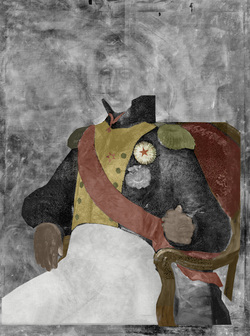
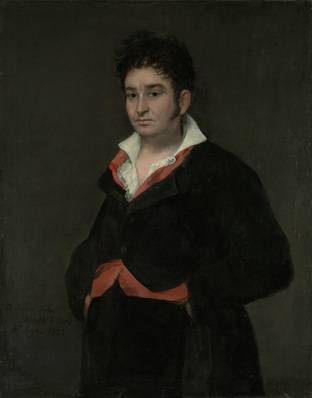
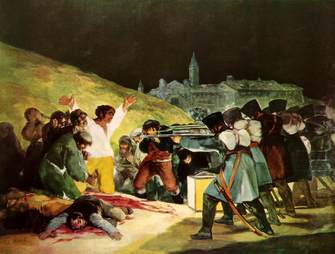
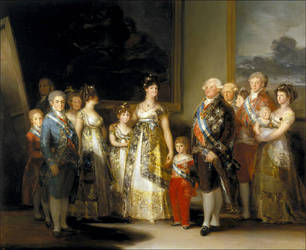
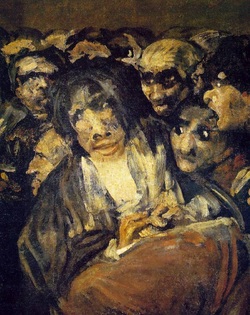
Click the link below for an interactive look at the new and old Goya portraits (Thanks to The Guardian UK)
http://www.guardian.co.uk/artanddesign/interactive/2011/sep/20/goya-painting-satue-rijksmuseum-interactive?intcmp=239
| artsmarttalk.com |
|
 Goya has always been hard to pin down. The discovery of a 'new' portrait, albeit hidden under an existing one, just adds to the complex story of this fascinating artist. Who is among the most modern of 'old masters'? Goya. Who made his living painting fawning portraits of powerful court patrons? Goya. Who is one of the most subversive of all painters? Goya. Who was one of the first realist painters? Goya. Who painted the darkest, most terrifying images in all of art? Goya. And did I mention that he had 24 children? The new painting, an unfinished formal portrait of a man wearing the important bling of a Napoleonic officer (it may even be Joseph Bonaparte, appointed King of Spain by his brother the Emperor) was discovered with the fresh out of the box Scanning Macro X-ray Fluorescence Spectrometry, a technology developed in the Netherlands and Belgium. This is a technique that "fires high-energy x-rays at the painting, which energizes the atoms causing them to release their own x-rays. By observing and analyzing this information, researchers are able to develop a color map of what lies beneath the top layer of paint. The result shows remarkable detail about what was originally on the canvas."(thanks to Geekosystem.com)  The portrait on top - the only one that counts for most of us - is one of Goya's masterpieces and the only painting by Goya in the Netherlands (at the Rijksmuseum.) It is a beauty - the subject is Judge Don Ramón Satué, a man in whose face intelligence, skepticism, compassion, and confidence all jockey for position. His hair is fashionably feathered forward, his black velvet costume, accented with white ruffles and red sash, is stylishly comfortable - no formal robes for this judge. It was painted in 1823, ten years after the French were driven out of Spain. It seems probable that Goya was commissioned to paint the underlying portrait during the French occupation; one speculation about the reuse of the canvas is that he needed to get rid of any evidence of collaboration once Ferdinand VII was restored to the Spanish throne.  It's unlikely that Goya would have cooperated willingly with Napoleonic forces. His powerful The Third of May from 1808 is an eyewitness account of injustice; it screams out Goya's protest against the inhumanity of that occupation with his pitting of an innocent man - clearly marked as a symbol of all innocence by his bright white shirt and crucifix pose - against the faceless brutality of a uniformed firing squad. Click to set custom HTML  Goya lived at one of the cruelest and most crucial cusps of history, a time when old tyrannies were exploding in revolutions. Harsh, inhumane oppressions in response, did little to stem the tide of inevitable progress towards equality and democracy, but led to wide-spread misery for many innocent people. Goya witnessed all of this - in his work we find the cycle of history. The golden, sunlit days of court life edge into clear-eyed observations and documents of the wealthy and powerful, perhaps with a touch of muffled but barbed criticism, as in his celebrated portrait, The Family of Carlos IV.  The march of his witness continues - he spares no detail about the unspeakable horrors of war with his incredible series of etchings, The Disasters of War. We then watch him descend into a personal world of darkness, losing his hearing, going into exile in Bordeaux, and creating the searing, unspeakable Black Paintings and Horrors. Click the link below for an interactive look at the new and old Goya portraits (Thanks to The Guardian UK) http://www.guardian.co.uk/artanddesign/interactive/2011/sep/20/goya-painting-satue-rijksmuseum-interactive?intcmp=239
2 Comments
 The Philadelphia Museum of Art, stately and grand, perched on its acropolis like the literal and figurative temple of art that it is, contains never-ending pleasures of great reach and subtlety. You may be aware of the stellar European and American holdings - The Gross Clinic by favorite son Thomas Eakins is a highlight - but you might be surprised to find that its strengths include breathtaking Eastern art and architecture and a fine contemporary collection. 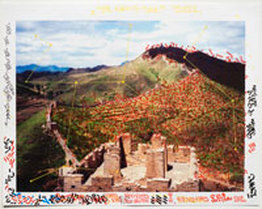 And, better than some other major museums I could mention, PMA makes an effort to reach out to the local art community, a move appropriate for a city with some of this country's top art schools, most within walking distance of the museum. At the moment, the result of this effort is the small but intriguing show Here and Now: Prints, Drawings, and Photographs by Ten Philadelphia Artists. I'm a works on paper artist myself, so this show was right up my alley. The premise is - works on paper by a selection of local artists of sound repute to one degree or another "ranging in age from 25 to 50" (an arbitrary limitation that strikes an oddly foolish note) - two long-term professors must be the upper limit (their dates are conveniently left off the signage), but most are young, ambitious, and very up-and-coming if not already arrived. 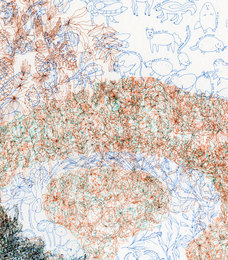 Two of the artists exhibit regularly at Gallery Joe, an excellent Old City showcase for works on paper: of the two, Mia Rosenthal was my immediate favorite. Her obsessive drawings pull you in close to to the twists and turnings on a hunt for the tiny little creatures that either are there, or that you imagine must be there, hiding in the foliage of her fine spidery lines. I especially loved the idea - and the fact too - of drawing the entire contents of a sample size box of Rice Krispies, laid out Krispie by Krispie in a sinuous necklace of precise, clean, detail on creamy paper. 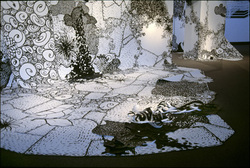 Astrid Bowlby, the other Gallery Joe artist, is known for pushing her drawing off the wall to create Alice-in-Wonderland-like environments. Her offerings for the PMA show are fairly tame but they give the idea. (This installation is not in the exhibit) 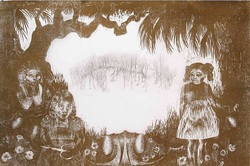 In contrast to the small scale of Rosenthal's work, Serena Perrone works large; her woodcuts have a rugged, energetic quality that she tempers with fine detailed drawing in gold point and silver point. It's a highly unusual pairing that is at once startling and soothing. 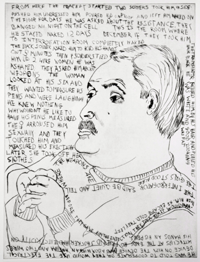 Daniel Heyman's provocative drypoints are art politics in action - reportage portraits of former Abu Ghraib prisoners, scratched into a metal plate (writing backwards) on the spot as the men related their stories to an American lawyer. The crisp, saturated compositions have the urgency of this morning's newspaper headlines, to use a rapidly again metaphor, but in fact, Heyman's drawings testify to a world that is out of step with progress.  The photographs in the exhibit moved me less but that may be the viewpoint of an observer partial to drawing and the work of the human hand. Isaac Tin Wei Lin managed to straddle the line between the two - bold ink cyber-patterns in soft but edgy harmony (or disharmony) with pastel toned photographs. The gallery for this show is easy to miss - across from the gift shop on the way to the cafeteria - a good space even if it feels a bit also-ran in such a grand museum. (Thanks to Gallery Joe for Bowlby and Rosental images) Here and Now: Prints, Drawings, and Photographs by Ten Philadelphia Artists is at The Philadelphia Museum of Art until December 4, 2011. This is your new blog post. Click here and start typing, or drag in elements from the top bar.
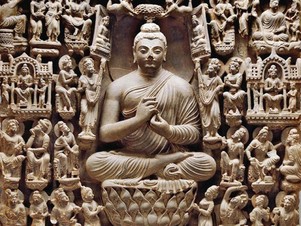 The lights are dim, carpeting keeps footsteps quiet, but the exhibit of Buddhist Sculpture at Asia Society is, in fact, a loud statement of courage and perseverance, as well as the power of art, in the face of a difficult political situation. The title of the exhibit, The Buddhist Heritage of Pakistan: Art of Gandhara, explains the problem - this show almost didn't happen. Melissa Chiu, director of the Asia Society Museum, said in a NY Times article “I persisted because this is a unique opportunity for us to show the cultural heritage of Pakistan at a time when U.S.-Pakistan relations are probably at their lowest ever.” And of course, the beauty of it is that, once inside and alone with the art, the world with all its hatreds and anger drops away, and the powerful poetry of this ancient work speaks for itself. 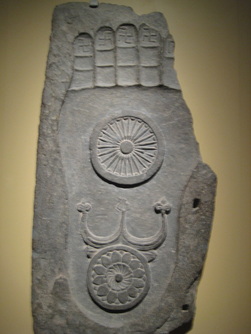 Much of it comes from the Lahore Museum, and many of the examples date from the first centuries CE - others are even earlier. The name Gandhara, an ancient kingdom at the junction of what are now Pakistan and Afghanistan, signifies an important watershed for Buddhist art. Here was the nucleus of an intermixing of Asian and Western traditions, prompted by trade along the Silk Road and the Hellenizing influence of Alexander the Great and his Roman successors. There was no human Buddha image before the art of Gandhara, only symbols such as the Buddha's footprints or the Dharma Wheel. (yes those are swastikas in the toes - one of the world's most ancient symbols, the swastika is present in many traditions as a benign representation of cosmic order.) 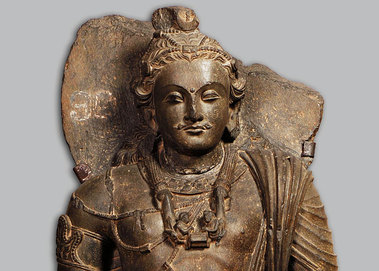 With Gandhara begins the new - now ancient - tradition of iconic statues and classical narratives that follow Greek forms of storytelling. Buddha became the calm figure of infinite grace that we often see seated on a lotus, his hands arranged in compassionate mudras, his empty ears stretched by the rich jewels he gave up to find enlightenment and set a path known as the Middle Way. There are chunks of ancient buildings in the exhibit, reminiscent of friezes on Greek temples, telling of the Buddha's conception by an elephant, his escape from the royal palace of his wealthy father, his miracles and teachings. With the Buddha are statues of Bodhisattvas, the holy figures that have not yet left the world: the most beautiful is Maitreya, still draped in jewels, who is prophesied to become Buddha on the next turning of the cycle. 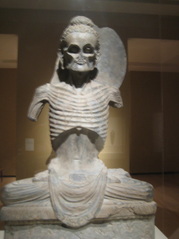 The opposite of beauty is death, represented by a rare statue showing the Buddha as a virtual skeleton whose veins clearly show on his bony forehead, coming to understand that the path of the ascetic is not the Way - it's a startling, compelling image.  But If only the sculpture showing the Buddhist Paradise had made the trip it would still have been a complex and interesting show. The piece is crammed with figures - above, below, and flanking the serene seated Buddha, who is being crowned with what looks suspiciously like a wreath of laurels. Paradise seems to promise much spiritual but also material comfort: Buddha still has no jewelry and fancy trappings but he's the exception. 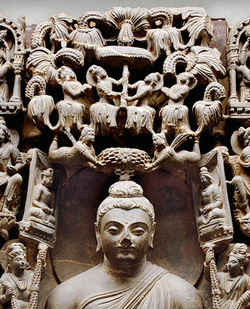 It looks like a comfortable place, even a bit like Hawaii, if we can trust the figures who look to be wearing grass hula skirts. This is a good place to see clearly the mix of cultures: the infrastructure is a mix of Roman arches, Greek columns, and Lotus Thrones. The exhibit is at Asia Society Park Ave and 70th Street, NYC, through Oct 30, 2011. http://sites.asiasociety.org/gandhara/exhibit-sections/buddhas-and-bodhisattvas/ 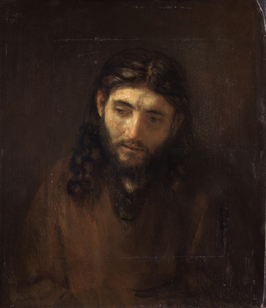 It's hard to imagine coming face to face with a celebrity: what would you do if Angelina Jolie suddenly showed up at your local supermarket? And when it comes to Jesus - famous, divine, historical/mystical - it's impossible. Art doesn't help. The model most people know, especially if they went to Sunday School, is a sort of candy-colored pretty Jesus who looks to be of vaguely Scandinavian heritage. Even 'good' art - and there is an enormous amount of good religious art - art history would be nowhere without Christian imagery - keeps Jesus at arm's length or further. Byzantine versions set the standard for the stern aloof Jesus, very beautiful, but definitely not someone you could sidle up to to ask for a favor. A most famous Byzantine image is Christ the Pantocrator - the Judge - one who appears disinclined to give time off for good behavior. The other extreme is Guido Reni's gentle, painfully beautiful 16th c. Jesus, who suffers great agony without any messy blood or dirt. 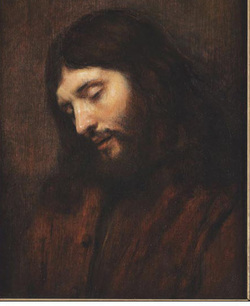 But then comes Rembrandt. A traveling exhibit, Rembrandt and the Face of Jesus, is now at the Philadelphia Museum of Art, after a stay at the Louvre, and before it goes on to Detroit. It's a small, focused show of quiet pleasures for a Rembrandt lover like me, with a good audioguide to give background on why his versions of Jesus are so revolutionary. First of all, this Jesus is Jewish, just as the real Jesus was. Rembrandt whose house was smack in the midst of the Jewish population of Amsterdam, delighted in the fresh possibilities of this exotic group, newly arrived after persecutions elsewhere. It is said that he became close friends with several Jewish neighbors, and he certainly found models for his oh-so-human Jesus. 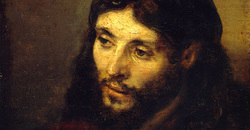 There is a wall of small studies of heads in the exhibit, the same but different by a slight twist of the neck or a shift in the glance. As I made my way from one to the next, the humanness of Jesus made itself felt, and by the end I could believe him fully capable of sadness, compassion, maybe a little anger, and even a head cold. 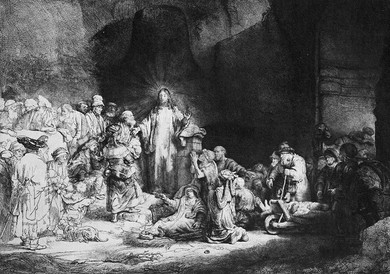 Christ Preaching 'Hundred Guilder Print' Etching by Rembrandt 1648 Rembrandt is the most unusual of religious painters for a number of reasons. Religious painting, long associated with the Roman Catholic Church, was far out of favor in fiercely Protestant, fiercely and newly independent 17th c. Holland. Icons and saints had been banished from the churches; artists painted portraits, landscapes, and earthy genre scenes. Rembrandt painted those too, but he also looked to the Bible, reading it for himself and looking around to see its lessons writ in the faces and gestures of his fellow Amsterdamers. His saints are a little dumpy, with fleshy Northern faces, and his Jesus is dark and human. Rembrandt was one of the greatest printmakers who ever lived, and the show includes several of his etchings as well as a short film about the etching process and his work with the medium. The print shown above, officially titled 'Christ Preaching' but known as 'The Hundred Guilder Print' for its high price, is one of Rembrandt's masterpieces. Watch it on the PMA exhibit site at http://www.philamuseum.org/exhibitions/409.html |
Share ArtSmartTalk
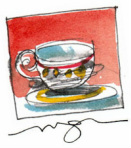
MacGregor-Art.com Cards and art gifts with a Fine Sense of Fun Also at http://www.etsy.com/shop/MacGregorArt ArtSmart Consulting
|
| Blog: |
| ArtSmartTalk |
Topics: |
| Art History, Design, Art |
All
19th C Art4a3f8ec7db
20th C59300e1f29
African Art
Almutanabbi Streetbb1c3786e2
American Art
Ann Hamilton
Apple
Apple Computers
Arabic Poetry
Architecture
Art
Art And Nature
Art And Technology
Art As Collective Memory
Art Auctions
Art Books
Art Forgery
Art Galleries
Art History
Art In Gardens
Art Installation
Art Installations
Art Licensing
Art Of Spain
Art Prints
Art Technology
Baghdad Books
Barnes Collection
Biennial
Book Project
Books
Brooklyn Museum
California Design
Chelsea Galleries
Chess
Color
Constable
Contemporary Architecture
Contemporary Art
Contemporary Design
Design
Detroit Institute Of Arts
Drawing
E H Shepard
El Anatsui
Etching
European Art
Expressionism
Fabric Design
Flags
Folk Art
French Art
French History
French Portraits
Galleries
George Bellows
Goya
Goya Black Paintings
Goya Portrait
Hand-made Books
Historical Art
Hokusai
Ho Tanner
Illustration
Installation Art
Iraq
Jean Clouet
Lacma
Lewis Chessmen
London
Los Angeles
Mac Computers
Mary Cassatt
Matisse
Met Museum
Metropolitan Museum
Metropolitan Museum Of Art
Modern Art
Modern British Painting
Moma
Moma Ps1
Moons
Museums
Napoleon
National Gallery
Nature
New Architecture
New Art
New Design
New Goya Painting
New York
New York Art
Norse Art
Novels About Art
Old City Philadelphia
Online Art Sites
Outdoor Art
Outsider Art
Painting
Paris
Pat Steir
Performance Art
Philadelphia
Philadelphia Art
Philadelphia Museum
Photography
Plein Air
Portraits
Product Design
Red
Religious Art
Rembrandt
Rome
Rothko
Royal Portraits
Sarah Sze
Scottish Art
Self-portraits
Significance Of Art
Sketching
Southern California
Soutine
Spanish Art
Spanish History
Steve Jobs
Technology
Thanksgiving
The Importance Of Art
Turner
Van Gogh
Velasquez
Venice Biennale
Whitney Museum
Words And Art
Young Artists
August 2013
May 2013
February 2013
January 2013
December 2012
November 2012
October 2012
September 2012
August 2012
July 2012
June 2012
May 2012
April 2012
March 2012
February 2012
January 2012
December 2011
November 2011
October 2011
September 2011
August 2011
July 2011